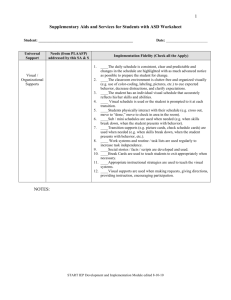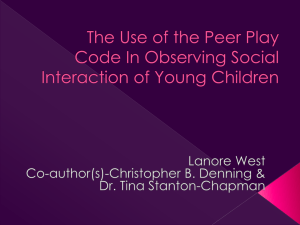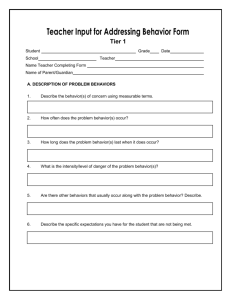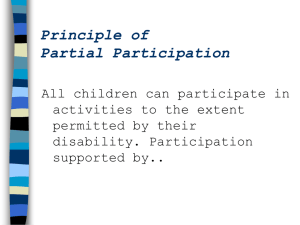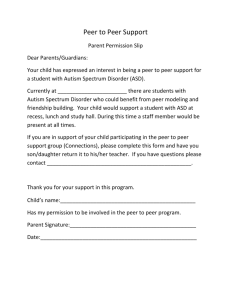Student USAPT draft
advertisement
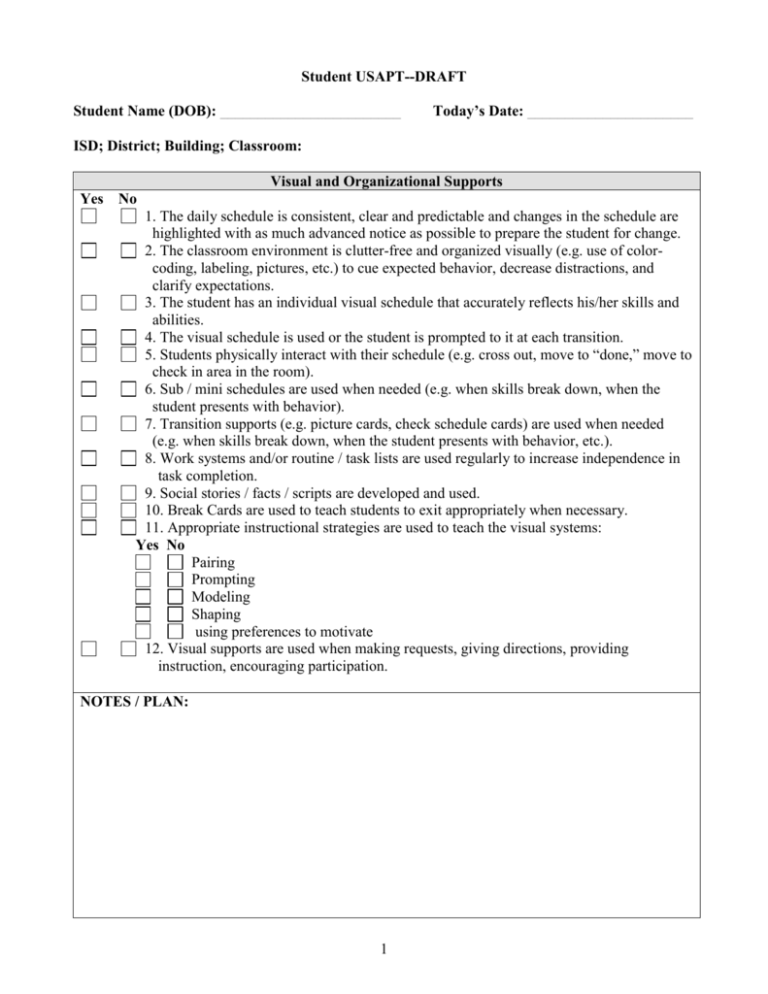
Student USAPT--DRAFT Student Name (DOB): ________________________ Today’s Date: ______________________ ISD; District; Building; Classroom: Visual and Organizational Supports Yes No 1. The daily schedule is consistent, clear and predictable and changes in the schedule are highlighted with as much advanced notice as possible to prepare the student for change. 2. The classroom environment is clutter-free and organized visually (e.g. use of colorcoding, labeling, pictures, etc.) to cue expected behavior, decrease distractions, and clarify expectations. 3. The student has an individual visual schedule that accurately reflects his/her skills and abilities. 4. The visual schedule is used or the student is prompted to it at each transition. 5. Students physically interact with their schedule (e.g. cross out, move to “done,” move to check in area in the room). 6. Sub / mini schedules are used when needed (e.g. when skills break down, when the student presents with behavior). 7. Transition supports (e.g. picture cards, check schedule cards) are used when needed (e.g. when skills break down, when the student presents with behavior, etc.). 8. Work systems and/or routine / task lists are used regularly to increase independence in task completion. 9. Social stories / facts / scripts are developed and used. 10. Break Cards are used to teach students to exit appropriately when necessary. 11. Appropriate instructional strategies are used to teach the visual systems: Yes No Pairing Prompting Modeling Shaping using preferences to motivate 12. Visual supports are used when making requests, giving directions, providing instruction, encouraging participation. NOTES / PLAN: 1 Peer to Peer Support Yes No 1. Information about ASD and the student with ASD is provided to the typical peers in the classroom/building in a way that respects parent and student preferences. 2. Staff maximizes opportunities and creates activities / situations that encourage interactions with typical peers throughout the day. 3. Typical peers are actively recruited as peer to peer supports. 4. Peer supports are trained to interact appropriately and effectively with the student. 5. Staff prompts typical peers to initiate and sustain interactions with students with ASD. 6. Peer to peer support students attend regular meetings to support the student (i.e., case conferences). 7. Mediums of Exchange are identified to promote effective interaction with typical peers. 8. A system exists to maintain typical peer involvement with the student (e.g., appreciation activities such as lunch gatherings). NOTES / PLAN Accommodations / Modifications Yes No 1. The student has sufficient opportunities in the general education environment to make progress in academic, independence, and social competency skills. 2. The general education curriculum is used as the primary focus of instruction. 3. Goals and objectives are developed based on the general education curriculum and environment as well as targeted social, independence, and communication skills. 4. Effective instructional practices are used to build new skills (e.g., shaping, task analysis, reinforcement). 5. Specific academic accommodations to the general education curriculum are selected and implemented based on individualized needs and reflected in the I.E.P. goals. 6. Specific academic modifications to the general education curriculum are selected and implemented based on individualized needs and reflected in the I.E.P. goals. 7. A system is developed to assure that the specific academic accommodations and modifications are implemented throughout the student’s educational program. 8. A system is used to determine appropriate grading based on the specific accommodations and modifications to the general education curriculum. 9. Progress toward student goals are assessed at least weekly and necessary changes are made to programming to ensure improvement. 10. The student takes the MEAP or participates in MI Access. NOTES / PLAN 2 Functional Communication System Yes No 1. Assessment of the student’s communication involves observation of all forms of communication (verbalizations, gestures, pictures, behavior) currently used by the student across environments, as well as the functions of problem behaviors (e.g., whether student problem behaviors communicate protests or requests). 2. Families and relevant team members actively participate in the selection and teaching of the appropriate communication system for student which may include verbal, signbased, picture-based (e.g., PECS), augmentative devices, or a combined approach. 3. The communication system chosen matches student skills, needs, and environments, is functional, portable, and available in all environments. 4. Staff in the child’s environment consistently responds to and validates both conventional communication attempts (use of verbalizations, gestures, and functional communication systems) and unconventional communication attempts (nonverbal behaviors or problem behaviors). 5. Unconventional communication attempts such as yelling and using adults as “tools,” are consistently used as opportunities to teach the functional communication system. 6. Staff initiates communication with students with ASD in all environments and activities by prompting, questioning, offering choices and starting conversations. 7. Staff consistently encourages responding through gesture, sign, icons and spoken language. 8. Students are specifically taught communication systems that address: Problem behavior functions (e.g., protests or requests) Social-communication targets (e.g. responding to greetings, initiating and sustaining interactions or conversation) Pragmatic social-communication targets (body language and personal space). 9. Appropriate instructional strategies are used to teach the communication systems: Pairing Prompting Modeling Shaping Using preferences to motivate 10. Communication data are regularly collected to ensure that students are consistently using functional communication systems across environments and activities, and with multiple partners (teachers, families and peers). NOTES / PLAN 3 Positive Behavioral Interventions & Supports Yes No 1. Effective Tier 1 (Universal) strategies that prevent challenging behavior are developed and implemented with fidelity for the student. Yes No Functional communication systems Visual supports and strategies Peer supports Breaks Ordering of activities Pre-teaching/ pre-corrects OTHERS (describe): ________________________ 2. If implemented Tier 1 strategies have not addressed challenging behaviors, a problem solving approach founded in functional behavior assessment is utilized to develop targeted (Tier 2) interventions and supports. 3. Tier 2 interventions and supports are implemented with fidelity. 4. If the student continues to have challenging behaviors despite implementation of Tier 1 strategies and Tier 2 interventions and supports, a full functional behavior assessment (Tier 3) is used to develop a positive behavior support plan. 5. Functional behavior assessments employ multiple methods of data collection (e.g. direct observation, scatterplot, rating scales, and interviews) to determine the function of challenging behaviors. 6. The positive behavior support plan includes antecedent strategies (i.e., proactive strategies intended to prevent behaviors from occurring). 7. The positive behavior support plan includes strategies for teaching and prompting new skills (e.g. communication, social interaction, independence, replacement behaviors). 8. The positive behavior support plan includes appropriate, non-emotional, non-verbal, and nonpunitive strategies for responding to behavior. 9. If needed, a crisis plan is developed for responding to dangerous and emergency situations. The crisis plan complies with the Michigan Department of Education, Office of Special Education and Early Intervention Services policy “Supporting Student Behavior: Standards for the Emergency Use of Seclusion and Restraint.” 10. The positive behavior support plan and/or crisis plan is reviewed with all relevant staff and implementation training is provided as needed. 11. Data on the fidelity of implementation of the positive behavior support plan are collected and reviewed regularly by the team. 12. Behavioral data at all tiers are collected regularly and used as the basis for decision-making about strategies. 13. The positive behavior support plan is implemented consistently in all environments. 14. There is a reporting system in place between school staff and family members to provide regular updates on behavioral interventions and their effectiveness. NOTES / PLAN 4 Adult Support Yes No 1. Adults in the student’s environment actively promote independence by teaching systems (e.g. visual schedules, self-management systems) that allow the student to complete tasks with as little assistance as possible. 2. Additional adult support is assigned only when the student needs direct academic, behavioral or social support that cannot be provided by peers. 3. Responsibilities for additional adults are clearly communicated. 4. A list of strategies the additional adults are required to implement with the student is provided (e.g. visual supports, prompting, reinforcement, and crisis plan). 6. Adults in the child’s environment demonstrate respect for students (e.g. talking to instead of in front of students, etc.). Adults demonstrate respect for students’ needs by interacting at an age appropriate level, and talking to, rather than in front of students. 7. Training, mentoring, and implementation support are offered regularly and required for the adults working with the student with ASD. 8. Appropriate supervision, observation, and performance feedback is provided regularly to additional adults(s). 9. Fading of adult support occurs as soon as data shows the student is learning systems that allow him/her to complete tasks independently. NOTES / PLAN IEP Development, Implementation and Evaluation Yes No 1. The PLAAFP focuses on strengths and needs related to functioning in the general education environment. 2. IEP goals are prioritized based on needs identified in the PLAAFP. 3. IEP goals have observable and measurable objectives. 4. At a minimum, IEP goals include communication and social skill development. 5. Supplementary aids and services considers the following key areas for the student: Yes No functional communication systems visual supports peer to peer support accommodations / modifications positive behavior supports appropriate use of paraprofessional support 6. Programs and services maximize time in the least restrictive environment. 7. The IEP is developed to enhance independent functioning. 5 8. A system is in place to document implementation of the IEP. 9. A data collection system is in place to assess progress toward goals and objectives weekly. 10. Data collected on progress toward goals and objectives is used to make program decisions. NOTES / PLAN 6

